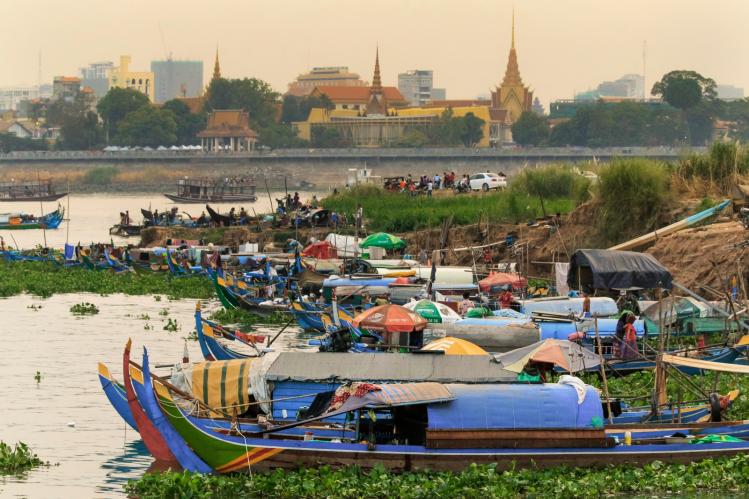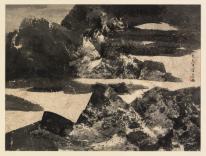
A morning jog—and attentiveness to street signs—can teach you about a city’s past and present, and maybe even reveal hints of its future.
So I discovered on a recent predawn run in Phnom Penh. Smells of woodsmoke and baking bread, the coo of doves nesting among the stupas of the pagoda on Street 135: a peaceful route for exercise that early hour of the day. Things got busier as I reached the street’s end and turned onto a six-lane road where traffic hummed loud and fast. The road’s name? Mao Tse-Tung Boulevard. The nomenclature made a certain sense, as I realized when I continued along and passed the sprawling embassy compound of the People’s Republic of China.
Still, it startled me. Not only did Mao spawn disasters within his own country (the famines of the Great Leap Forward and the persecutions of the Cultural Revolution come instantly to mind); he was also an ideological supporter and the chief financial backer of the cruelest political movement ever to afflict Cambodia—Pol Pot’s Khmer Rouge.
The deference implied by the signage has its own logic. From the 1980s to the present, one man has dominated the nation’s governance: a former Khmer Rouge battalion commander named Hun Sen, who has aligned his foreign and domestic policies so closely with Beijing’s as to make Cambodia effectively a satrapy of China. (A few months ago he announced his son Hun Manet would succeed him as prime minister, but Sen remains very much a controlling presence.) Everywhere you go, the Khmer Rouge legacy is anything but past. In November, my wife, Jody, and I drove to Siem Reap—home to the temples of ancient Angkor—and visited the Catholic church of St. John the Apostle. There, a priest showed us wooden crucifixes carved by craftsmen injured and disabled by landmines the Khmer Rouge planted during Cambodia’s civil war, which remain a hazard to this day. What strikes you as you gaze at the Corpus on the cross is its physiognomy: the right leg is shorn off at the knee. The sculptors offer a Christ who is maimed and crippled, who has assimilated into his own body the same flesh-shearing trauma that these artists know too well. The message—for anyone who has been wounded in any way by life—is stark and clear: the man-god Christ is truly man; whatever we endure, he’s suffered before.
Damage and yet survival: we saw another example on returning to Phnom Penh. A short ferry ride takes you from the city’s heart to a riverside village called Areyksat, home to a Catholic church known as Queen of Peace Chapel. It serves a largely Vietnamese congregation, many of them impoverished fisherfolk dwelling in shacks or sampans on the water. Queen of Peace has become famous for two large statues retrieved from the river some fifteen years ago. Both depict the Virgin Mary: one shows her with the rosary; the other has her cradling the Christ Child.
The statues were dumped into the river during Pol Pot’s regime, at a time when the Khmer Rouge was destroying churches and other places of worship throughout Cambodia. Little else is known about them. The fishermen who found them were Buddhist and Muslim, but they knew the figures were sacred and so donated them to the church. European in style, the statues likely date to the French colonial era of the late nineteenth or early twentieth century. Both are weathered; the nose of one is broken. Worshippers lay gifts of fresh flowers daily; when we visited, they were burning joss sticks and bowing before each figure in turn. We were told people of various faiths—not only Christians—come to show homage to the Virgin. Inside, children sang chants in her honor. A girl handed us a Vietnamese-language devotional brochure entitled “Our Lady of the Mekong Pilgrimage Program.” A placard outside proclaimed, “May Mary, Mother of the Mekong River, bless all of you.”
The Mekong could also use her blessing. In recent years the river has sustained significant environmental damage. The worst offender has been Communist China, which has erected numerous dams in Yunnan province that siphon off much of the Mekong’s water upriver from the neighboring countries of Southeast Asia. An organization called Mother Nature Cambodia (MNC), founded in 2012, is working to confront the nation’s environmental challenges. It has been the object of both persecution and acclaim. For years, the Cambodian government has waged what Human Rights Watch calls a “continued vendetta” against MNC. (More encouragingly, MNC received international recognition in winning an award from Sweden’s Right Livelihood Foundation last November.)
While in Phnom Penh, Jody and I were able to meet and speak at length with three MNC members: a young man named Phay Phanya and two young women, Long Kunthea and Phuong Keo Reaksmey. “Call me Ah Keo,” she told us when we met. (The term “Ah” in colloquial Khmer is used affectionately with names of young people.) In their early- to mid-twenties, they exhibited energy, idealism, and purpose—and a very evident passion for Cambodia’s natural habitat and its people.
They told us about some of MNC’s activities since its founding, including an early effort to organize protests against a proposal by two Chinese firms—Sinohydro Corp and China Guodian Corp—to build a dam in the Areng Valley of Koh Kong province. The project would have flooded a rainforest sacred to Buddhists and destroyed the livelihood of thousands of local villagers. MNC drew nationwide attention to this proposed construction; monks from Phnom Penh and beyond converged on the valley, marching through the forest in a long line and wrapping saffron robes around trees in an act of consecration. “If you kill the tree after it’s been consecrated,” Phanya told us, “it’s like killing a monk: bad karma, bad things will happen to you.” The message was clear: these trees were sacred, the forest was holy, and the government had no business setting up deals without prior consultation to sell off people’s traditional lands to China or anyone else.
The protests were a success. Public outcry was so great that the deal collapsed and the Chinese companies withdrew. “But we stay vigilant,” Phanya concluded, “in case they try something again.”
These days, MNC devotes special attention to protecting Koh Kong, a coastal province in the nation’s southwest that is home to the rainforests of the Cardamom Mountains. In recent years, the government has sold off parcels of Koh Kong forest land to political allies in the ruling Cambodian People’s Party (CPP). (Leaders of opposition parties have been imprisoned, exiled, or murdered.) Chinese real-estate developers, such as the Tianjin Union Development Group, have also purchased forest concessions. Among the most high-profile corporations exploiting the region is the LYP Group, owned by Chinese Cambodian entrepreneur Ly Yong Phat. Ly is a well-connected CPP senator, known officially as a “special economic advisor” to the nation’s head of state and—unofficially—as “the king of Koh Kong.”
MNC has helped publicize the unregulated activities of these corporations: dredging that threatens coastal mangrove ecosystems; illegal logging of rare timber, such as rosewood; chock-a-block development—casinos, hotels, condominiums—along once-pristine coastlines; and commercial sugarcane plantations that replace old-growth forest. MNC activists have also met with local traditional agriculturalists who have been driven off their land without being compensated.
Members of MNC have also been active in Phnom Penh itself—though sometimes at great personal risk. Ah Keo and Kunthea told us they’d been arrested after posting videos on Facebook and YouTube protesting the government’s plan to fill in Boeung Tamok, one of the last freshwater lakes in Phnom Penh, to allow development of highrises and luxury housing. As members noted in one video, such lakes are vital as natural urban reservoirs. Filling in Boeung Tamok would only worsen the flooding on the streets of Phnom Penh during the city’s seasonal monsoon storms. The lake is also a refuge for many species of birds.
To educate the public on Boeung Tamok, MNC announced an action that would be dramatic enough to highlight the urgency of the issue but small enough that the government (which has a history of harassing MNC) couldn’t deem it a threat. The plan was for one woman—Kunthea—to walk solo from Wat Phnom (the city’s most famous pagoda) to the prime minister’s residence. She would be dressed in white to show sadness, lamentation, and purity of intention, and would carry a lotus, the flower of rebirth and enlightenment. Ah Keo would follow to record and live-stream Kunthea’s journey. Simple. Unthreatening.
But not according to the police. The day before the planned walk, the two were arrested, then subjected to months of pre-trial detention. In May 2021, each was sentenced to eighteen months in prison for “incitement to commit a felony or cause social unrest” by publicly questioning the government’s plan to fill in Lake Tamok. They ended up serving fourteen months, with the rest of the sentence suspended. But the government can send them back to jail at any time at the first sign of further protest.
I asked Ah Keo and Kunthea what jail had been like, and was not surprised to hear about the physical conditions. There were 172 other cellmates and only two toilets. Ah Keo said the personal floorspace she’d been allotted measured 1.8 meters by sixty centimeters (roughly six feet by two). But you have to pay for that space; prisoners without money are made to sleep in the corridor, in front of the latrines. “Which means,” she said, “your face gets wet from the wet feet of people entering and leaving the bathroom and stepping over you.”
Were such conspicuously political prisoners subjected to abuse by prison officials or fellow inmates? To my surprise, no. “The only people really angry with us,” said Kunthea, “are the tycoons who destroy the environment. Most Khmer people were very supportive.” Indeed, both said that many guards and wardens exhibited a tacit sympathy. “They can’t show support openly,” Kunthea explained. “Some people fear for their families, and they fear the government.” Yet prison officials offered small kindnesses. The two women were allowed to listen to Radio Free Asia in the vehicle on the way to court, and back in prison they could listen to Voice of America on the radio. “Some criminals told us, ‘I’m in here for my crimes; but you shouldn’t be here at all,’” Kunthea said.
Now that they’re out of jail, they want to re-emphasize one of MNC’s major themes: encouraging Cambodia’s “new generation of Khmer youth” to develop a love for the natural world. To accomplish this, MNC has initiated programs ranging from a plastic-waste education campaign to study-tour expeditions in which young urban students go to rural areas and learn about life in the nation’s forest communities. They also want to establish more programs to protect Cambodia’s environment from the government and its tycoon-cronies. Kunthea, who is in her third year of law school in Phnom Penh, mentioned that as part of her own efforts she has helped teach fellow students about the principles of environmental legislation. “Of course,” added Ah Keo, “we know we have to be ready to go back to prison at any time.”
Heartbreaking, to hear the gallantry and quiet courage in this young woman’s voice. But such things also give hope.
Please email comments to [email protected] and join the conversation on our Facebook page.
Share
Previous Story
An Anatomy Lesson
Next Story
Preaching the Real Presence

